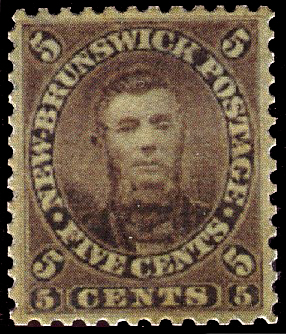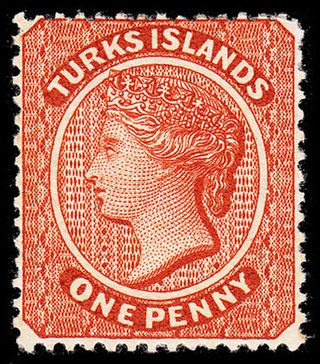
This is a survey of the postage stamps and postal history of New Brunswick .

This is a survey of the postage stamps and postal history of New Brunswick .
A total of eleven stamps were issued by New Brunswick. [1] The first stamps were issued in 1851 [2] and are similar in design to a contemporary set issued by Nova Scotia. This set of three diamond-shaped issues continued until 1860 when the next and final issue was released.

Commissioned by the postmaster of New Brunswick Charles Connell, the colony's second issue is notable in several ways. First, it is believed to include the first steam ship (12½ cents) and first steam train ever shown on a postage stamp (relating to the European and North American Railway, of which Mr. Connell was a director), and third because it contained the first commemorative stamp, a 17 cent stamp featuring an image of a youthful Prince of Wales (King Edward VII) wearing highland dress, issued because the Prince of Wales was scheduled to visit the colony in 1860. The most notable aspect of the issue, however, was that the postmaster chose to include his own image on the five cent issue. This caused such a political uproar in the colony that Connell resigned, but not after destroying most of the stamps. [3] The five cent stamp was replaced by one featuring the reigning monarch, Victoria. [4]

New Brunswick stamps were superseded by those of the Canada when the colony became part of the Dominion on July 1, 1867.

Philately is the study of postage stamps and postal history. It also refers to the collection and appreciation of stamps and other philatelic products. While closely associated with stamp collecting and the study of postage, it is possible to be a philatelist without owning any stamps. For instance, the stamps being studied may be very rare or reside only in museums.

Charles Connell was a Canadian politician, now remembered mainly for placing his image on a 5-cent postage stamp. Born in Northampton in the then-British colony of New Brunswick to a family of Loyalists who had fled the American Revolution, he entered politics in 1846, serving in the colony's Legislative Assembly and House of Assembly.

The postal and philatelic history of Canada concerns postage of the territories which have formed Canada. Before Canadian confederation, the colonies of British Columbia and Vancouver Island, Prince Edward Island, Nova Scotia, New Brunswick and Newfoundland issued stamps in their own names. The postal history falls into four major periods: French control (1604–1763), British control (1763–1841), colonial government control (1841–1867), and Canada, since 1867.

The postage stamps and postal history of British Columbia started in 1860 with the issue of a single brownish-rose stamp depicting Queen Victoria in profile and denominated as 2½ pence. It was issued jointly by Vancouver Island and British Columbia as each colony had insufficient postal trade to justify printing separate stamps. In 1862, Vancouver Island adopted decimal currency and sold the stamp for 5 cents, before issuing its own 5 and 10 cent stamps in September 1865. Meanwhile, British Columbia had increased the postal rate to 3 pence but continued to use the unified stamp. In November 1865, British Columbia issued its own stamps and the unified stamp became invalid. In 1866, the two colonies were united as British Columbia.

This is an overview of the postage stamps and postal history of Australia.
The Straits Settlements of the Malayan Peninsula have a postal history distinct from the other Malayan areas.
Each "article" in this category is a collection of entries about several stamp issuers, presented in alphabetical order. The entries are formulated on the micro model and so provide summary information about all known issuers.

Aden is a city in southern Yemen. Aden's location made it a popular exchange port for mail passing between places around the Indian Ocean and Europe. When Captain S. B. Haines of the Indian Marine, the East India Company's navy, occupied Aden on 19 January 1839, mail services were immediately established in the settlement with a complement of two postal clerks and four letter carriers. An interim postmaster was appointed as early as June 1839. Mail is known to exist from 15 June 1839 although a regular postmaster was not appointed until 1857; one of the officials of the Political Agent or the civil surgeon performed the duties of postmaster for a small salary.

The Chalon Head is the name of a number of postage stamp series whose illustration was inspired by a portrait of Queen Victoria by Alfred Edward Chalon (1780–1860).

Sir Edward Denny Bacon was a British philatelist who helped with the enlargement and mounting of collections possessed by rich collectors of his time and became the curator of the Royal Philatelic Collection between 1913 and 1938.

Plating refers to the reconstruction of a pane or "sheet" of postage stamps printed from a single plate by using individual stamps and overlapping strips and blocks of stamps. Likewise, if a sheet 10 or 20 postal cards is typeset, the variations of the letters or design elements may allow reconstruction or plating of the sheets based on these differences.
Bangladesh first issued its own postage stamps upon gaining independence in 1971. A set of eight stamps, with various motifs including a map of the country, were issued. Shortly after, stamps in eight values were overprinted "Bangladesh Liberated" in both English and Bengali were prepared in the United Kingdom, but only three values were issued in Bangladesh.
The Stamp Specialist is the title of a series of books on philatelic research written and edited for the advanced collector of postage stamps.
Quindalious Greene was a Canadian philatelist, so prominent in the field of Canadian philately that he was often referred to as “Canada's Grand Old Man” by fellow philatelists.

The colony of the British Virgin Islands has issued its own stamps since 1866. The first Post Office was opened in Tortola in 1787. At the time postage stamps were not yet invented, and it was not until 1858 that a small supply of adhesive stamps issued by Great Britain depicting Queen Victoria were utilized by the local Post Office. These stamps were cancelled by an A13 postmark and are extremely rare so cancelled.

Postage stamps have been issued in the Turks and Caicos Islands since 1867.

This is a survey of the postage stamps and postal history of Nova Scotia.
Nicholas André Ambrose Argenti was a British stockbroker who served as a captain in the British Army during the First World War and a Squadron Leader in the Royal Air Force in the Second. He was at one time Chairman of the Nuclear Investment Company Limited.